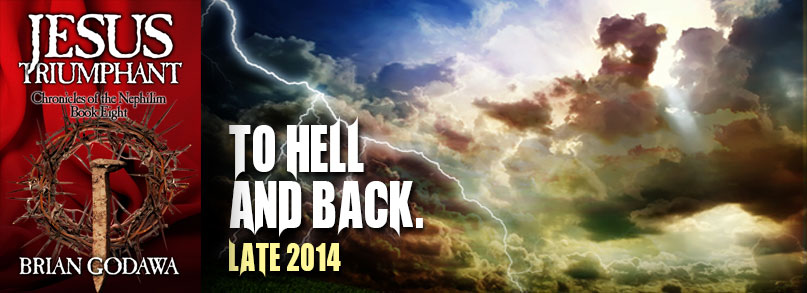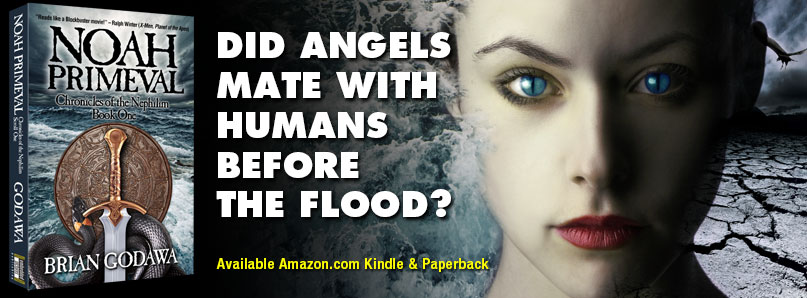 Special thanks to Darren Aronofsky and Paramount for raising the discussion of Noah with the new movie.
Special thanks to Darren Aronofsky and Paramount for raising the discussion of Noah with the new movie.
Buy the novel Noah Primeval, here on Amazon.com in Kindle or paperback. The website www.ChroniclesOfTheNephilim.com has tons of way cool free videos, scholarly articles about Watchers and Nephilim Giants, artwork for the series, as well as a sign-up for updates and special deals.
•
•
•
Christ’s Descent Into Hades/Sheol
One of the most difficult and strange passages in the New Testament is 1 Peter 3:18-22. It’s oddity is only matched by the fact that it is connected to another difficult and strange passage in the Bible: Genesis 6:1-4. The Genesis passage speaks of the Sons of God mating with the daughters of men in the days of Noah and breeding Nephilim giants that lead to the judgment of the Flood.
1 Peter 3 is notorious for its difficult obscurity and lack of consensus among scholarly interpretation. Views are divided over it with a variety of interpretations to pick from. So, let’s take a look at it more closely with an attempt to clarify its meaning.
1 Peter 3:18–22
For Christ also suffered once for sins, the righteous for the unrighteous, that he might bring us to God, being put to death in the flesh but made alive in the spirit, in which he went and proclaimed to the spirits in prison, because they formerly did not obey, when God’s patience waited in the days of Noah, while the ark was being prepared, in which a few, that is, eight persons, were brought safely through water… Jesus Christ, who has gone into heaven and is at the right hand of God, with angels, authorities, and powers having been subjected to him.
When Did Christ Go on His Journey?
Some believe it was after Christ was resurrected in his body that was “spiritualized” by the Holy Spirit. The oldest most traditional view was that this occurred when Christ was dead. It was his “living spirit” that is being contrasted here with his “dead flesh” on the cross or in the grave. But whether Christ proclaims in his resurrected body or in his immaterial spirit, the next question arises, who are the spirits to which he proclaims and where are they? This will help clarify the picture.
Who are the Spirits in Prison?
The identity of the spirits has been debated extensively and falls into four possible categories: Human spirits, demons, fallen angels, or a combination of the above.
John Elliot debunks the notion that “spirits” refers to human beings by looking at the Greek word for spirits (pneuma) in Biblical and Intertestamental texts. He concludes, “use of ‘spirits’ for human beings is very rare, and even then it is always qualified. In the Bible and related literature, when reference is made to deceased humans in Hades or the underworld, the term used is not pneuma but psyche.” (1)
But another commentator, Ramsey Michaels, shows that “spirits” (pneuma) is used of demons frequently in the New Testament for those supernatural beings that Jesus often confronted in his ministry. (2) He points out that in 1 Enoch (a likely source text for this passage), pneuma is used of both the giants and demons as the surviving part of the giants killed in the Flood.
1 Enoch 15:8-10
But now the giants who are born from the (union of) the spirits and the flesh shall be called evil spirits upon the earth, because their dwelling shall be upon the earth and inside the earth. Evil spirits have come out of their bodies.
But what of the fallen angelic Sons of God (also known as Watchers)? Are they ever referred to as “spirits”? As the 1 Enoch 15 passage above shows, the spirits of the Nephilim hybrids comes from their angelic Watcher progenitors who are also called spirits. In verse 4 of that passage, Enoch condemns the Watchers for violating their heavenly being as spirits (pneuma) and defiling themselves with “the blood of the flesh begotten children.” (3)
The only other New Testament Scriptures that speak of imprisonment of spirits are Jude 6 and 2 Peter 2:4, the very passages that are literarily dependent on the book of 1 Enoch. (4)
Jude 6 (NASB95)
And angels who did not keep their own domain, but abandoned their proper abode, He has kept in eternal bonds under darkness for the judgment of the great day
2 Peter 2:4
God did not spare angels when they sinned, but cast them into hell [Tartarus] and committed them to chains of gloomy darkness to be kept until the judgment…
1 Enoch 12:4; 10:12
the Watchers of heaven who have abandoned the high heaven, the holy eternal place …bind [the Watchers] for seventy generations underneath the rocks of the ground until the day of their judgment.
Jude not only quotes Enoch outright in Jude 4, but throughout his entire letter, he follows the progression of ideas in 1 Enoch and references memes and motifs from that ancient source text. 2 Peter 2 is considered a paraphrase of Jude with the addition of the word for Tartarus as the description of the location of punishment.
Tartarus was well known by the ancients as the lowest place of the Underworld where the Titans were bound in pagan mythology. That Underworld was referred to as Hades (Greek) or Sheol (Hebrew), and has obvious conceptual links to Jude and Peter’s location of punishment (see below for more on Tartarus and Hades). (5) It would make most sense that Peter’s second letter about angels bound in the prison of Tartarus would have continuity with the “spirits in prison” he is writing about in this first letter.
But the spirits are specifically indicated as being those who were disobedient during “the days of Noah while the ark was being prepared.” That “days of Noah” is exactly the time period that 1 Enoch speaks of the fallen Watchers and their giant progeny receiving their comeuppance with a binding in Tartarus/Hades at the Flood.
1 Enoch 10:11-13
And to Michael God said, “Make known to [the angels] who fornicated with the women…bind them for seventy generations underneath the rocks of the ground until the day of their judgment and of their consummation…in the prison where they will be locked up forever.
Chad Pierce makes a convincing argument that the disobedient spirits are not just the Watcher angels, demons, or human spirits alone, but the sum total of all who defied God at that time because cosmic powers are often united with human powers in the ancient world. (6)
In the Bible, the angelic power over Persia animated the human kingdom of Persia (Dan. 10:13), The Roman human kingdom in Revelation is granted its power from Satan (Rev. 12-13), and both are destroyed together in the Lake of Fire (Rev. 19:20; 20:7-10).
Wink explains that the ancient mind of the Biblical writers was steeped in a macrocosm/microcosm of “what is above is also below.” “Angelic and demonic activity in heaven was reflected in events on earth…These Powers are both heavenly and earthly, divine and human, spiritual and political, invisible and structural.” (7)
Reicke adds that the “fallen Angels… the Powers, the demons in general, can in a certain way represent the whole world of fallen angels.” (8) It appears that the author of 1 Pet 3:18-22 has left the recipients of Christ’s message purposefully vague so as to include all forms of evil beings. The spirits in prison are thus all the forces of evil which have now been subjugated and defeated by Christ.” (9)
In the next post, I will take a look at just what did Jesus actually “proclaim” to these imprisoned spirits?
Buy the novel Noah Primeval, here on Amazon.com in Kindle or paperback. The website www.ChroniclesOfTheNephilim.com has tons of way cool free videos, scholarly articles about Watchers and Nephilim Giants, artwork for the series, as well as a sign-up for updates and special deals.
FOOTNOTES
John H. Elliott, 1 Peter: a New Translation with Introduction and Commentary (vol. 37B; Anchor Yale Bible; New Haven; London: Yale University Press, 2008), .
2 Matt 8:16; Luke 10:20; “unclean spirits” in Matt 10:1; Mark 1:27; 3:11; 5:13; 6:7; Luke 4:36; 6:18; Acts 5:16; cf. Rev 16:13; “evil spirits” in Matt 12:45//Luke 11:26; Luke 7:21; 8:2; Acts 19:12–13 (for the singular, cf. Matt 12:43//Luke 11:24; Mark 1:23, 26; 3:30; 5:2, 8; 7:25; 9:17, 20, 25; Luke 8:29; 9:39, 42; 13:11; Acts 16:16, 18; 19:15–16).” J. Ramsey Michaels, 1 Peter, vol. 49, Word Biblical Commentary (Dallas: Word, Incorporated, 1998), 207.
3 Charlesworth, The Old Testament Pseudepigrapha vol. 1, 21.
4 Nickelsburg, 1 Enoch: a Commentary, 7. Also, E. Isaac, “A New Translation and Introduction,” in The Old Testament Pseudepigrapha, vol. 1 (New York; London: Yale University Press, 1983); Robert Henry Charles, ed., Pseudepigrapha of the Old Testament, vol. 2 (Bellingham, WA: Logos Bible Software, 2004), 178.
5 See the Appendix of Brian Godawa, Enoch Primordial (Los Angeles, Embedded Pictures Publishing, 2013), 336-338.
6 Chad Pierce, Spirits and the Proclamation of Christ: 1 Peter 3:18-22 in Its Tradition-Historical and Literary Context, (Durham theses, Durham University, 2009), 215-218. Available at Durham E-Theses Online: http://etheses.dur.ac.uk/13/
7 Walter Wink. Naming the Powers: The Language of Power in the New Testament (The Powers : Volume One), (location1552-1553, 182-183.) Kindle Edition.
8 Bo Reicke, The Disobedient Spirits and Christian Baptism (New York: AMS Press, 1946), 121.
9 Pierce, Spirits and the Proclamation, 218. See also Reicke, The Disobedient Spirits, 121.















